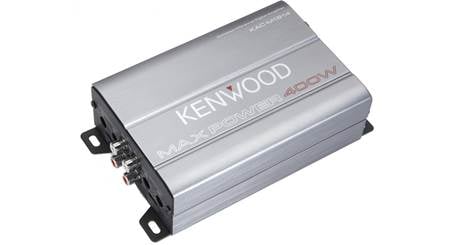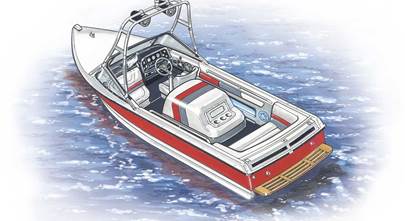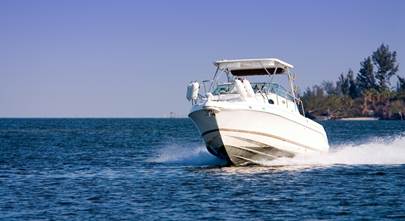Installing an amp on a boat: running power and ground wires
It's simple — just run the wires to the battery
In brief: If you're thinking about revamping your boat's stereo system, you already know that wiring is a big part of the job. This article takes a quick look at some of the basic things you'll need to know, like how to run power and ground wires.

Boats are not the same as cars
"Where the heck do I ground this thing?" I can neither confirm nor deny that I said something to that effect the first time I installed an amplifier on a boat.
You see, I was used to installing amps in cars, and when you do that, you run power wire directly to the car battery, then secure the ground wire to bare metal somewhere on the vehicle's chassis. But on a vessel made primarily of fiberglass and wood, this just isn't an option.
[Give your boat's stereo system a power boost it needs with a new marine amplifier]
The ground wire goes to the battery
Luckily, the solution is simple: you run both wires directly to the battery. Well, to the secondary battery, that is. All boats will have a primary battery for ignition and critical electronics, and a second battery for everything else that needs power. "Everything else" includes your stereo system.

As with automotive applications, you connect the power wire directly to the positive battery terminal, and include a fuse and fuse holder no more than 12" from the battery. But unlike a car, instead of hunting for a factory bolt that touches bare chassis metal, you simply run the ground wire along the same path and attach it directly to the negative battery terminal. Finish the signal and speaker wiring, mount the amp, and you're ready to rock.

Use marine-rated wiring
Speaking of wiring, make sure you choose wiring that's made for life on the water. Marine-rated wiring is an essential part of any boat's stereo system, because if you don't use the right stuff, all your awesome new audio equipment will turn into ballast before you know it.
[Check out our selection of marine-rated wiring for your amps and speakers]
Have more questions? We have answers!
If you're on the fence about whether or not your boat needs an amplifier, check out our Marine Amplifier Buying Guide to learn more. If you're new to the idea that your boat can have a great-sounding stereo system or aren't even sure what your options are, take a look at our library of marine audio articles.
Once you're ready to start shopping, our friendly Advisors can help you decide what you need to build the best possible stereo system for your boat. There’s even a team of Crutchfield marine advisors who specialize in helping boat owners build awesome audio systems.
And remember, when you buy your gear from Crutchfield, you get free lifetime tech support. Our Virginia-based tech experts are here seven days a week, so if you hit a snag during your installation, don't hesitate to contact us.


















Terry from South Vienna, OH
Posted on 4/11/2023
I have installed a clarion amp and 2 tower speakers on my boat. It all works, but I am getting the high pitched sound from the speakers once the amp kicks on. I have read that this is a ground loop issue. Both the power and ground are run to the battery. I have also tried running the ground with the radio and it still happens. The hiss does not come out the other 4 speakers which are directly hooked to the head unit. What am I missing?
Jon Paul from Crutchfield
on 4/12/2023
pete from Slidell
Posted on 9/7/2022
Question - thinking about installing an amp. Power run to positive on battery, can I run ground to a busbar? Also, if I run power to 2nd battery, will the amp receive power when the battery switch is on battery #1 main starting battery?
Crutchfield Writing Team from Crutchfield
on 9/8/2022
Brian Nehring from Fairfield
Posted on 6/16/2022
If I install an amplifier into my fishing boat, can I wire it into one of my two trolling motor batteries? Or will that not work because the two batteries are connected to run my 24v trolling motor?
Jon Paul from Crutchfield
on 6/17/2022
Matt from Concord, NH
Posted on 7/6/2021
As with most boats I presume, there is no "chassis ground" and as a result, I'll be running my 4 gauge ground wire back to the battery negative terminal. Is there any issues running the power and ground together back to the battery? Or should these by isolated? I believe it is ok as they are both insulated.
Lee from Lynchburg
Posted on 3/31/2021
Mat your suggestion that you simply run wires to your battery precisely why an old boat refit starts with ripping out all the wiring. If you have a panel like the one in the photo there is no reason to run wires back to the engine room and adding another connection to your battery. Add or combine a switch in the panel and use the negative buss behind the panel. DIYer's run wires to their batteries and hook up directly do all the time and over time make a huge mess of their electrical systems. My current boat had 50% of its wiring going nowhere, just hanging in the engine room or a locker connected to nothing. There were over ten wires connected to the house battery bank. That is not acceptable by any standard. A simple solution is to add a power distribution bar positive and negative near the battery bank if you don't have room in your panel. Just stop adding more connections directly to your battery bank. In the long run you will have a better install and a system with far fewer problems. IMHO.
Thomas from Amsterdam
Posted on 3/29/2021
I have planned to install my Pioneer gm-dx874 amp running off a separate leisure battery in my campervan. Since the amplifier is right next to the battery, I prefer to bring the negative wire back to the negative terminal, than removing the wood panelling to get to the chassis. Would this be alright in terms of safety and sound quality? It's pretty much the described boat situation. Thank you in advance!
Matt Freeman from Crutchfield
on 4/1/2021
Matt kish from Indianapolis
Posted on 8/11/2020
I have a 1991 four wins 200 horizon and I'm looking to install a Pyle 400 watt amp. Will my single battery loose any functionality while running my amp, four speakers, and a head unit? I'm just concerned if it is safe and will not kill my battery after a long day on the water. Thanks!
Matt Freeman from Crutchfield
on 8/13/2020
R Wentworth from Btl Crk Mi
Posted on 7/6/2020
As a former IASCA competitor and pro installer I ALWAYS RUN AN AMPLIFIER POWER GROUND TO THE BATTERY. In my 25 years as an installer I found that most vehicle grounding connections to be less than what amplifiers can demand , yet big enough for the vehicle. This allows the amp to "breathe" per se' ,, and avoids potential noise problems.
Jonathan Waldrop from Seneca SC
Posted on 6/17/2020
I have a fusion msra70nsx hooking to a wet sounds htx-6. The media receiver has zone 1 outputs and zone 2 outputs and also has sub outputs but right now I'm not running a sub. Can I run 2 y rca cables from the zone 1 rcas and hook them to channels 1-4. Then just hook up zone 2 as you would normally?
Dan from Battle lake from Battle Lake MN
Posted on 5/22/2020
I have a Clarion XN3410 that is blowing both 30amp fuses right as they are put in. This is Amp 2 for the ski boat tower speakers. The rest of the system is working fine off of Amp 1. Any first thoughts?
Alexander H. from Crutchfield
on 5/25/2020